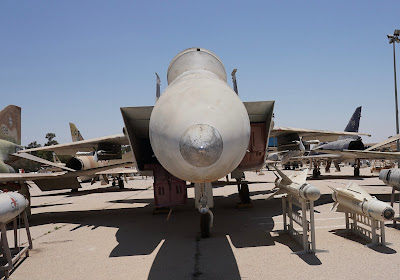Israel first acquired the F-15 Eagle in October 1976.
Not called the Eagle in IAF service, as that name went to the A-4, The F-15 has the moniker "Baz" IOn IAF service meaning Falcon. As you might guess, the F-16 Fighting Falcon has a different name in the IAF as well.
In IAF service, the F-15 has an impressive 61 to none kill ratio, including shooting down MiG-25s. No Israeli F-15s have been lost in combat, but at least three have been lost in training accidents.
This particular aircraft at the museum is responsible for 4 of those kills, sporting 4 Syrian aircraft kill rings.
That the F-15 is a superlative aircraft is beyond question. In Service with multiple nations, it has a 102-0 kill ratio.
Even when damaged, the F15 still can bring its crew home.
In 1983, an Israeli F-15, damaged in a collision, during a training exercise lost an entire wing but was still able to land safely, a testament to the strength and excellence of the aircraft design and the cool head of the pilot.
You can see and hear the pilot involved in that event retell what occurred:
In 2011, an Israeli F-15D suffered severe damage from a bird-strike from a flock of Pelicans. It was repaired using the parts of a single seat Israeli F-15, most likely a C model, and has been named FrankenBaz or FrankenEagle. The repair cost $1 million, cheap when considering a replacement F-15D runs about $40 million.
Even as Israel begins to acquire the F-35, the F-15 will continue to serve as an air superiority fighter and intends to continue to fly updated versions in tandem with the F-35.
Israel has continued to improve the F-15, improving its avionics and weapons systems while in its service.
The F-15E Strike Eagle has also been placed into service by the IAF with a modified version to fit Israeli requirements, the F-15I Ra'am (Thunder) currently in service with Israel's 69 Squadron, The Hammers.






No comments:
Post a Comment